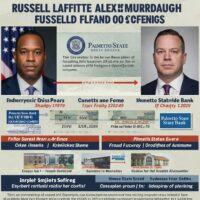Remarks as Prepared for Delivery
Thank you so much, Director Dettelbach.
And, thank you to the women and men of the ATF for hosting us today.
Thank you all for being here and for your commitment to our shared mission of keeping the American people safe.
I also want to acknowledge the dedicated members of the U.S. Attorney community here today—U.S. Attorneys Diggs, Esparza, Hamdani, Restaino, Simonton, and Uballez. Thanks for the work you are leading across this country to combat firearms trafficking.
It’s also great to be here with Deputy Secretary John Tien and the Deputy Homeland Security Advisor, Josh Geltzer.
And I’m grateful to Ambassador Ken Salazar for taking time out from the Chief of Missions conference to be here for this important discussion.
Although we represent different agencies, we share the same commitment to fighting the epidemic of gun violence that has shattered communities across our country.
Disrupting illegal firearms trafficking networks—those that operate within our borders and across them—is central to our efforts on both fronts.
The size and scale of the gun and drug trafficking networks we confront demand a united, comprehensive approach.
That is why we are here today.
The ATF is focused on using all of its authorities to prevent the trafficking of illegal firearms in the United States.
As you all know, the majority of firearms trafficked into Mexico—including high caliber and assault weapons—are shipped from the United States. The rise of privately made firearms, or “ghost guns,” has only made this problem more acute.
These weapons empower drug cartels to intimidate local communities, challenge state authority, and expand their deadly drug trade back into the United States.
Tragically, some of these weapons have been used against Mexican security forces bravely seeking to capture cartel leaders responsible for so much death and destruction both in Mexico and the United States.
That’s why we at the Department of Justice have ramped up our efforts to combat this challenge in four essential ways.
First, under Director Dettelbach’s leadership, we have increased joint operations with our Mexican law enforcement partners through Operation Southbound—the Department’s signature initiative to disrupt the trafficking of firearms from the U.S. to Mexico.
Since its creation, Operation Southbound has deployed nine Firearms Trafficking Task Forces to eight cities along the Southwest Border.
Focused on the trafficking of firearms to Mexico, these teams include partners from Homeland Security Investigations, Customs and Border Protection, and state and local law enforcement, as well as prosecutors across the U.S. Attorney community and the Department’s Criminal Division.
As a result of these combined efforts:
- Nearly 2,000 firearms were seized from last October to just the past March—a more than 65% increase over the same period last year.
- Over 80,000 rounds of ammunition were seized in the same period—also a substantial increase since last year.
In this room today, we have gathered the ATF leadership and U.S. Attorneys that are driving that success. Thank you, in advance, for the sustained commitment, energy, and initiative that we will build on in the days ahead.
Second, in partnership with the Government of Mexico, we have expanded access to the ATF’s eTrace system to enable Mexican law enforcement to quickly track the origin and purchaser of crime guns. In the last several months, nearly 12,000 traces were submitted to ATF by Mexican government agencies, and over a third of those were successfully traced to a purchaser.
Third, last year the Department of Justice established a new cartel weapons trafficking group along the Southwest border—led by U.S. Attorneys. It has already taken concerted action against firearm-trafficking networks.
Lastly, we are using new criminal authorities established by the Bipartisan Safer Communities Act to identify and hold firearms traffickers accountable.
Our agents and prosecutors have now charged over 100 defendants with violations of these new firearms-trafficking or straw-purchasing provision, or in some cases, both. The firearms-trafficking provision has proven particularly useful at the Southwest Border, as more than half of all cases charging that new offense have been brought by border-state U.S. Attorneys’ Offices.
There are many important investigations that the U.S. Attorneys here today will highlight, including a joint ATF and HSI investigation that resulted in the arrest of Michel Bacasegua-Barriga, the alleged leader of a prolific transnational firearms trafficking group based in Nogales, Sonora. Barriga was arrested in May in partnership with Mexico’s FGR and is being prosecuted by the U.S. Attorney’s Office for the District of Arizona.
Another example of your collective efforts is the prosecution of Roberto Lugardo Moreno Jr. in the Southern District of Texas, a case that was made possible by cooperation with Mexican law enforcement officials. Moreno, who has pleaded guilty, straw purchased an AR-15 in Texas that was transported to Mexico and linked to the notorious kidnapping and murder of U.S. citizens in Matamoros just a few months ago.
These are just two examples of the outstanding work that U.S. and Mexican law enforcement are performing every day to combat cartels, trafficking organizations, and violent crime. But we must do more. Together with our partners across government, including Deputy Secretary Tien and Ambassador Salazar, we are committed to deepening our coordination and enhancing our efforts to protect our communities.
I urge all of us here today to redouble our efforts in the following ways:
First, we know that data driven efforts yield better results. To successfully combat firearms trafficking, we need reliable, actionable data that can be shared in real time.
To help drive this effort, I have designated a senior prosecutor in my office—Mike Ben’Ary—to lead this process and to identify new opportunities to foster cooperation and data sharing.
Second, we must maintain the momentum in disrupting southbound firearms trafficking during the summer months. This means pooling our resources to continue gaining ground against the cartels and those who arm them.
And third, it is critical that we continue to strengthen our cooperation with our Mexican partners.
In conversations with the highest levels of Mexican law enforcement, I confirmed that we are aligned on the firearms challenge and the need to do more. Recently, Mexican Attorney General Gertz and his Deputy Attorney General Gallo established a vetted unit to work exclusively on firearms trafficking and to focus on strategic enforcement efforts.
By working with this new unit, we hope to increase information sharing and access to seized firearms. That information, in turn, will allow us to trace these weapons to their source in the U.S. and identify the networks that traffic them to Mexico.
In just a few months, senior officials from the Mexican and United States governments will gather for the U.S.-Mexico High Level Security Dialogue, to focus on our shared security interests—including combating firearms trafficking.
In closing, I want to thank all my colleagues here today. Through the work of your teams, we are showing our resolve in going after violent gun trafficking networks. I’m confident with your leadership we can continue our vital work to keep our communities safe.
Thank you very much.
Speaker: Lisa O. Monaco, Deputy Attorney GeneralComponent(s): Office of the Deputy Attorney General
Updated June 14, 2023 Original Article













